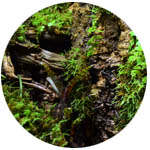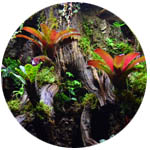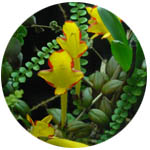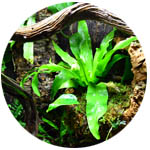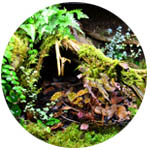
Fruit Fly & NEHERP Fly Media Care
Everything you need to know to build great fly cultures using our NEHERP Fly Media!
Introduction To Culturing Fruit Flies
Fruit flies are extremely inexpensive and easy to care for feeder insects which are popular in the amphibian, reptile, invertebrate, and even fish keeping hobbies. This guide will help explain how to build great fly cultures from start to finish using top-quality NEHERP supplies, and will also offer a few tips & tricks for maximizing production. We work with two species of Fruit Fly, and each species has two sub-types. Both varieties of the melanogaster species are smaller, faster producing, and more forgiving than the two hydei varieties. Choosing which fly to start with will depend on the species of animal being fed, as well as your own personal preferences. If you are new to culturing flies, we recommend starting with either type of D. melanogaster for best results.
Selecting Which Fruit Fly
There are two common species of fruit fly used in the hobby, and each species has two common variants to choose from. We'll run through the differences between each below, but it's important to note that both types of D. melanogaster fruit flies are significantly more forgiving & faster to produce than D. hydei. If you are just starting out, we'd strongly recommend either variety of D. melanogaster. None of the flies below can fly. We only work with & recommend flightless varieties.
D. melanogaster
'Wingless'
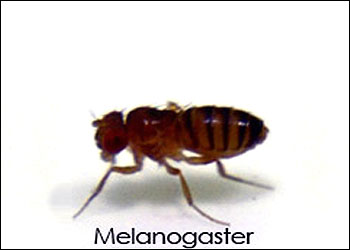
Size: 2.5-3mm (Smallest)
Production Rate: Fast (4-6 days to larvae)
Production Volume: Thousands of flies per culture
Difficulty: Easy
Other Info: An excellent starter feeder fly. This wingless variety produces very quickly & reliably. These are the first flies we commercially bred & sold here at NEHERP.
D. melanogaster
'Turkish Glider'

Size: 2.5-3.5mm (Small)
Production Rate: Very Fast (3-6 days to larvae)
Production Volume: Thousands of flies per culture
Difficulty: Easy
Other Info: Arguably produces slightly faster than standard D. melanogaster. While these flies can't fly upward, they can glide, which adds enrichment for the animals in our care.
D. hydei
'Flightless'
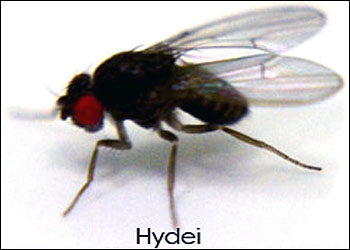
Size: 3.5-4mm (Smallest)
Production Rate: Slow (8-12 days to larvae)
Production Volume: Hundreds of flies per culture
Difficulty: Average
Other Info: Great for species requiring slightly larger prey, with flies about the size of pinhead crickets. Keep below 80F to prevent mutation into flying flies.
D. hydei
'Golden'
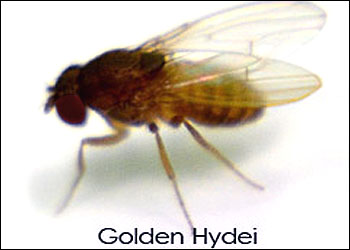
Size: 2.5-3mm (Smallest)
Production Rate: Fast (4-6 days to larvae)
Production Volume: High (Thousands of flies)
Difficulty: Easy
Other Info: Great for species requiring slightly larger prey, with flies about the size of pinhead crickets. Ever-so-slightly larger & faster producing than black D. hydei.
How To Culture Fruit Flies
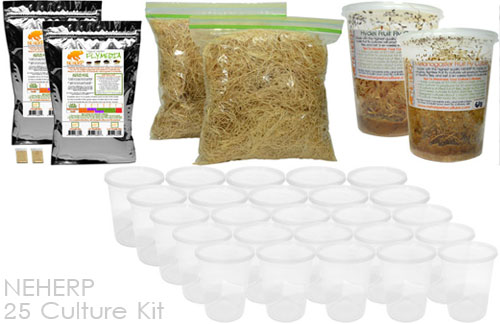
What You'll Need:
• Fruit Flies
• Fruit Fly Media
• 32oz Deli Cup(s)
• Vented Fabric Lid(s)
• Excelsior
• Hot Water
• White Vinegar (Strongly Recommended)
• Baker's Yeast (Free w/Media)
★ Get everything at a discount: NEHERP Fly Culture Kit! ★
Instructions:
1) Add 1/4 cup hot water to empty 32oz deli cup
2) Add 1/3 level cup NEHERP Fly Media (Wait 30 seconds for water to absorb)
3) Shake 'till remaining dry media is level
4) Evenly pour 1/4 cup hot water over remaining media
4a) If necessary, use a spray bottle to moisten dry spots
4b) Add a splash (or spray) of vinegar for best results (Important!)
5) Sprinkle baker's yeast (10-15 grains) on top of the media
6) Add a loose ball of low-dust excelsior high in the cup
7) Add flies (40-100) and cap the lid quickly!
Production Schedule Of Fruit Flies


Drosophila hydei Production Schedule
Applies to D. melanogaster + D. melanogaster 'Turkish Glider'
Melanogaster flies will usually show larvae within 4-6 days, and begin producing around the 11-13 day mark. Cultures typically produce until day 30-35 without issue, though they typically slow down considerably after day 27-28. This species will produce thousands of smaller flies over a shorter time period; actively producing for 18-23 days in ideal conditions.
Drosophila hydei Production Schedule
Applies to D. hydei + D. hydei 'Golden'
Hydei flies produce slower, and will begin to show larvae around 8-12 days after a culture is created. Hydei begin to produce around day 19-22, and will typically produce past day 35. Many hydei cultures only start slowing down past day 40! This species will produce hundreds of larger flies over a longer time period; actively producing for upwards of 18-20+ days in ideal conditions.
Tips & Tricks for Great Fly Cultures
• Never mix or stir our media. Unmixed cultures built using the above instructions will out-produce and outlast cultures that are mixed/stirred.
• For best results, use the available vinegar spray bottle we offer with the purchase of our media. A single "spritz" to a culture before adding excelsior will do wonders for the production & lifespan of the culture.
• Remember to add yeast. A little sprinkle goes a long way to help that live fungi out-compete naturally occurring spores in our environments. We include more than enough in every shipment, so apply liberally!
• Please don't use boiling water. Our media contains nothing that needs further sterilization. Boiling water in a tiny plastic cup can be dangerous, and makes our media more soupy than it needs to be. Hot tap water works great.
• We recommend keeping your fruit fly culture storage area between 70-75F and 50-60% R/H for best results.
• Be sure to fully saturate the media. Leaving dry pockets will marginally slow the rate of production while increasing the likelihood of encountering a culture crash.
• Avoid starting cultures from the first flies to emerge from a culture, as doing so selectively breeds flies for unwanted (fast breeding, shorter life) traits.
• When flies begin to hatch out, try not to begin pulling from the culture for 3-5 days if possible. This extra time allows the flies to breed and add more eggs into the media, for longer culture life. Flies can breed at about 48 hours old, so allowing them 4-5 days before pulling can add thousands of eggs to a culture and increase a culture's longevity considerably.
• Don't let the culture get too crowded! If there are lots and lots of flies in your culture, we suggest pulling from it. Even if you don't need the flies right now, just throw them in a temporary container (or start new cultures) until they are needed. An overly crowded culture can crash out quickly.
• Keep cultures in ambient lighting, when possible. Darkness combined with high humidity can create moldy cultures, and will negatively affect production rates. Direct sunlight should also be avoided due to issues w/overheating. Normal, ambient room lighting is best.
• If your culture looks a bit too dry (common in summer months) adding water is a good practice; just make sure not to drown too many flies in the process! Rehydrating cultures is super easy with a spray bottle, and we typically rehydrate cultures by spritzing them with white vinegar at NEHERP.
Mite Prevention
To be clear, "mites" in this context are neither parasitic or microscopic in nature. The mites which may find their way into fruit fly cultures are generally harmless detritivorous species (or sometimes grain mites) which want to take advantage of the nutrients found in the media. These are not a danger to you or your pets (allergies aside), though they will drastically shorten the life of a culture and can act as a breeding ground for larger-than-normal populations of mites. We've built our reputation around offering the cleanest (mite free) fruit fly cultures in the USA. Please inspect them closely upon arrival for the added peace of mind! Having said that, every human home contains some harmless detritivorous mites which would love to make their way into your nutrient-rich fruit fly media. Following the proactive steps below may be helpful in preventing naturally occurring mites from finding their way into fruit fly cultures.
Mite Prevention Checklist:
1) Start with mite-free cultures. There is no effective way to "Demite" a culture, so starting with clean cultures is the #1 priority.
2) Start with top quality media & supplies which are not contaminated with mites.
3) Keep your culture storage area extremely clean by dusting and disinfecting surfaces frequently.
4) Do not keep cultures near vivariums, terrariums, houseplants, windowsills, shoe racks, laundry bins, mudrooms, or anywhere with porous flooring. Each of those places are hotspots for common household-dwelling mites.
5) Discard extremely old cultures as soon as they aren't useful to you. If you'll be holding them past 35 days, it may be worth keeping a separate area for older cultures, since they are more likely to encounter mite issues.
6) Using mite spray on paper towels and storing your cultures on top of the paper towels is a good standard practice.
7) Mite paper (difficult to find) is another really good option which follows the same concept as above.
Special Thanks ♥
The free informational articles on our website are made possible by the direct support of our small business's customers. By buying stuff at our shop, customers like you help fund everything we do from product development to article publishing. This article doesn't rely on ad revenue or paywalls, and contains no affiliate marketing. We do our best to remain unbiased by turning-down sponsorships, advertisers, or paid manufacturer promotions. Instead, our whole store's inventory and recommendations are based upon which supplies performed best in our real-world tests from 2009-to-present. If you found this article helpful and would like to help ensure it remains free & frequently updated, we hope you'll support our shop when it comes time to build your own terrarium. Our customers have helped make NEHERP possible for over a decade, and we couldn't be more grateful. ♥




